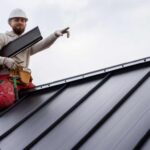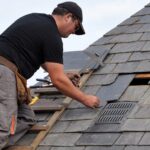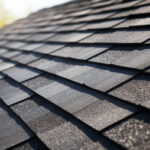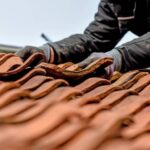When it comes to the longevity of different roofing materials, homeowners often ask, how long does a shingle roof last? It’s a vital question because the roof is a fundamental part of your home, offering protection against the elements.
This article will delve into the factors that affect the lifespan of shingle roofs, especially for homeowners eager to make informed decisions about their home’s maintenance and improvement.

Understanding Shingle Roofs
What is a Shingle Roof?
A shingle roof is a roof covering consisting of individual overlapping elements. These elements are usually flat, rectangular shapes laid in courses from the bottom edge of the roof up, with each successive course overlapping the joints below. Typically, these are made from materials like asphalt, wood, or metal. Understanding the various components will help you in determining how long does a shingle roof last.
Types of Shingle Roofs
There are different types of shingle roofs, including asphalt, fiberglass, wood, and architectural shingles. Each type has its unique qualities and lifespan influencing factors. Some of the most common shingle types and their expected lifespans include:
- Asphalt Shingles: Typically last about 15-30 years.
- Fiberglass Shingles: Generally, they last around 25-50 years.
- Wood Shingles: Often reasonably last for 30-40 years when properly maintained.
- Architectural Shingles: These may reach 30-50 years due their increased thickness.
Factors Influencing Shingle Roof Longevity
Quality of Materials
The durability of shingle roofs highly depends on material quality. Opting for higher quality shingles usually translates to a longer-lasting roof. This is where the importance of choosing the right materials becomes clear.
Installation Process
The quality of the installation process directly impacts how long your shingle roof will last. Properly installed shingles can last their entire expected lifespan or even longer, while poorly installed roofs may require repairs or a full replacement much earlier.
Climate and Weather Conditions
Climate plays a huge role in the longevity of a shingle roof. Areas prone to harsh weather conditions such as storms, heavy snow, or extreme heat can shorten the lifespan of a roof. Proper maintenance is especially crucial in these situations.
Benefits of Shingle Roofs
Cost-Effectiveness
Shingle roofs are often touted for their cost-effectiveness. The lower price point compared to other types of roofing makes them an attractive option for many homeowners. More information on the various materials used can be found here.
Versatility and Aesthetic Appeal
Shingles offer a range of styles, colors, and textures, providing homeowners the opportunity to select what best fits the architectural design of their homes. This versatility is a significant reason for the widespread use of shingle roofs.
Maintenance Tips for Longer Life
Regular Inspections
Routine inspections help in identifying issues early on. This can be done annually or after extreme weather conditions. Identifying problems early can significantly prolong the roof’s lifespan.
Timely Repairs
Addressing repairs promptly is one of the most critical factors in extending the life of a shingle roof. Damaged shingles can lead to leaks and other issues if not addressed swiftly.
Proper Cleaning
Keeping the roof clean from debris and moss can prevent moisture retention, which could lead to faster deterioration. A clean roof means a prolonged life for your shingles.
Gutters Maintenance
Blocked gutters can lead to water overflow, which might cause significant damage to your roof. Regular gutter maintenance is essential for the health of your roof.
Signs It’s Time for a Replacement
Leaks and Water Damage
If you notice water stains on your ceiling or walls, it could be a sign your roof needs replacing. Early identification of these signs is paramount to prevent more extensive damage.
Missing or Damaged Shingles
Missing, warped, or broken shingles can be a clear indicator that your roof is reaching the end of its lifespan. A thorough inspection can help in making more informed decisions.
Curling or Buckling Shingles
Curling or buckling usually indicates that the shingles are no longer providing adequate protection. These are signs of an aging roof often requiring immediate attention.
Choosing the Right Contractor
Research and Recommendations
Finding the right contractor is vital to ensure high-quality work. Look for recommendations and online reviews to guide your choices. You can learn more about choosing a contractor here.
Checking Credentials
Ensure all potential contractors are licensed and insured. This protects you from any liabilities during the roofing project.
Comparing Quotes
Request multiple quotes to ensure you’re getting a fair price for the work to be done. Comparing quotes and understanding what’s included in each one will help you make the best decision.
Conclusion
By understanding how various factors influence how long a shingle roof lasts, homeowners can make knowledgeable decisions about maintenance and replacement.
It’s always advisable to keep your roof in check, ensuring you receive the maximum benefit from your investment.
For more detailed insights into the costs associated with roof replacements, additional resources are available.

FAQs
Can shingle roofs withstand severe weather?
While shingle roofs are quite durable, severe weather can affect their longevity. Regular maintenance is key to ensuring they withstand harsh conditions.
Are shingle roofs environmentally friendly?
Some shingles are made from recycled materials and can be recycled themselves at the end of their use, offering an environmentally friendly option.
Is a roof warranty essential?
Yes, warranties offer peace of mind, ensuring you are protected against material failures or installation defects.
This article contains affiliate links. We may earn a commission at no extra cost to you.








